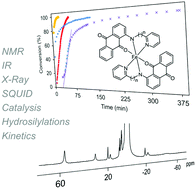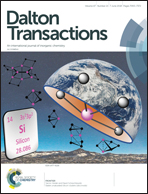A new anthraquinoid ligand for the iron-catalyzed hydrosilylation of carbonyl compounds at room temperature: new insights and kinetics†‡
Abstract
The reaction of 1-((2-(pyridin-2-yl)ethyl)amino)anthraquinone with either Fe(HMDS)2 or Li(HMDS)/FeCl2 allowed the preparation of a new anthraquinoid-based iron(II) complex active in the hydrosilylations of carbonyls. The new complex Fe(2)2 was characterized by single-crystal X-ray diffraction, infrared spectroscopy, NMR, and high resolution mass spectrometry (electrospray ionization). Superconducting quantum interference device (SQUID) magnetometry established no spin crossover behavior with an S = 2 state at room temperature. This complex was determined to be an effective catalyst for the hydrosilylation of aldehydes and ketones, exhibiting turnover frequencies of up to 63 min−1 with a broad functional group tolerance by just using 0.25 mol% of the catalyst at room temperature, and even under solvent-free conditions. The aldehyde hydrosilylation makes it one of the most efficient first-row transition metal catalysts for this transformation. Kinetic studies have proven first-order dependences with respect to acetophenone and Ph2SiH2 and a fractional order in the case of the catalyst.



 Please wait while we load your content...
Please wait while we load your content...